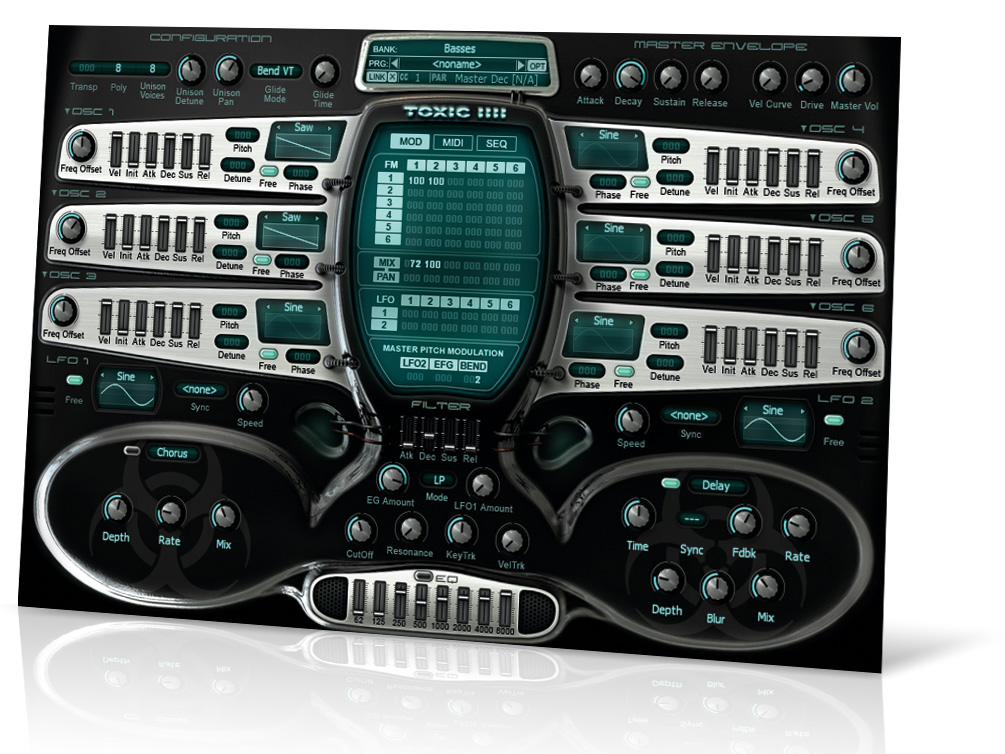MusicRadar Verdict
Biohazard is the best in the Toxic series thus far and represents incredible value for mid-level synth programmers.
Pros
- +
Superb value. Some lovely presets. Sensible interface. Improved effects. Now supports AU format. A slicker experience all round.
Cons
- -
Not a significant update.
MusicRadar's got your back
The Toxic hybrid synth is one of music software's best-kept secrets. It's capable of making some extremely expensive-sounding noises, yet retails for the equivalent of a mere £50,
As with previous editions, Toxic Biohazard uses a combination of frequency modulation and subtractive synthesis. Unlike many FM synths that rely on multiple screens to display oscillator and modulation information, almost all of Biohazard's controls are accessible at once.
The bits you'll use most are the six oscillator control panels (each of which has its own dedicated slice of interface real-estate), filter sections and frequency modulation matrix.
The oscillators are well-spec'd and feature 32 wave shapes, a gate retrigger mode and an initial level control, in addition to the typical ADSR. A frequency offset control is in place for each one, which comes in handy for creating FM effects, and each also features phase and tuning controls.
"As with previous editions, Toxic Biohazard uses a combination of frequency modulation and subtractive synthesis."
Biohazard's FM abilities are accessed via the frequency modulation matrix, which, along with the LFO mod matrix, is located in a display at the centre of the interface. This can be swapped for pages dealing with MIDI and step-sequencer control - a good compromise, as you probably won't feel the need to fiddle with the matrices while looking at the other screens.
The modulation display packs an awful lot into a small space without feeling fiddly or cramped, and is certainly a lot more inviting than FM8's noob-scaring plethora of pages. As such, it's a cinch to dive right in and start creating sounds, and even those who haven't used an FM synth before should find it easy to get to grips with.
The catch is that Biohazard's frequency modulation is less sophisticated than some of its competitors', and it's not possible for oscillators to modulate themselves. If you're already au fait with either of Native Instruments' FM synths or LinPlug and Maxx Claster's own Octopus, there's not much here that you won't have seen before.
Want all the hottest music and gear news, reviews, deals, features and more, direct to your inbox? Sign up here.
Improvements
In fact, Toxic owners won't find a lot of new ideas here either, but there are a few new additions that make it an overall better synth.
The biggest difference is that the effects section now features two slots, each offering Chorus, Delay, Reverb, Flanger, Phaser and Lo-Fi effects - this is greatly preferable to Toxic III's rather limited delay and chorus effects.
Image-Line's website makes much of the new "physical envelopes", but in our testing we found the difference between the envelopes in Toxic III and Biohazard to be negligible - the manual doesn't even mention the feature.
There are a number of other improvements worth mentioning, though, including an admittedly superior graphical interface, increased polyphony, MIDI learn functions, the ability to copy settings between oscillators, and the fact that the plug-in is now available in AU and FL Studio formats.
Summary
Despite a lack of significant improvement, this remains a great synth, and the solid bass tones and rich pads that emanate from it belie its bargain price tag. If you've yet to check the Toxic series or FM synthesis in general, Biohazard makes for a great introduction.
Check out three sounds from Toxic Biohazard's impressive palette:
Computer Music magazine is the world’s best selling publication dedicated solely to making great music with your Mac or PC computer. Each issue it brings its lucky readers the best in cutting-edge tutorials, need-to-know, expert software reviews and even all the tools you actually need to make great music today, courtesy of our legendary CM Plugin Suite.

